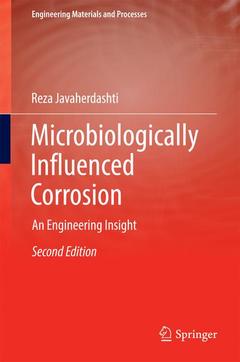Microbiologically Influenced Corrosion (2nd Ed., 2nd ed. 2017) An Engineering Insight Engineering Materials and Processes Series
Auteur : Javaherdashti Reza

*Mathematical modelling of MIC, in particular fuzzy logic
*A comparison of culture-independent methods with culture-dependent methods
*Further practical strategies for dealing with MIC
*Natural biocides
Focuses on providing easy-to-follow solutions for both engineers in practice and researchers
Introduces the concept of a human /management factor in dealing with microbiologically influenced corrosion (MIC) and shows that MIC must be taken into consideration in any strategic management planning
Examines the possibility of using fuzzy logics to predict the microbial corrosion phenomenon
Offers a “solution provision” approach based on years of field and research experience
Is unique in going beyond elucidation of known facts
Suggests mechanisms for the impact of CP on MIC, and the possible role of magnetotactic bacteria in enhancing microbial corrosion
Explores the largely-overlooked function of Clostridia in corrosion and the potential of using natural biocides
Discusses the fact that very different systems have the same MIC mechanisms
Includes supplementary material: sn.pub/extras
Date de parution : 10-2016
Ouvrage de 216 p.
15.5x23.5 cm
Date de parution : 04-2018
Ouvrage de 216 p.
15.5x23.5 cm
Disponible chez l'éditeur (délai d'approvisionnement : 15 jours).
Prix indicatif 137,14 €
Ajouter au panierThèmes de Microbiologically Influenced Corrosion :
Mots-clés :
Biocides and Microbial Corrosion; Cathodic Protection in Microbial Environments; Culture-dependent Methods Corrosion; Culture-independent Methods Corrosion; Fuzzy Logic for Microbial Corrosion; MIC; Magnetic Bacteria and Microbial Corrosion; Mathematical Modelling of MIC; Microbial Corrosion; Microbial Corrosion and Clostridia; Microbiologically Influenced Corrosion; Mitigating Microbiologically Influenced Corrosion; Natural Biocides and Microbial Corrosion; Practical Strategies Microbial Corrosion; Preventing Microbiologically Influenced Corrosion; Recognizing Microbiologically Influenced Corrosion; Stress Corrosion Cracking; Understanding Microbiologically Influenced Corrosion; biochemical engineering
